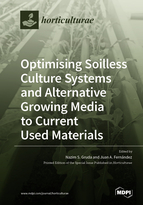Optimising Soilless Culture Systems and Alternative Growing Media to Current Used Materials
A special issue of Horticulturae (ISSN 2311-7524). This special issue belongs to the section "Protected Culture".
Deadline for manuscript submissions: closed (31 December 2021) | Viewed by 43632
Special Issue Editors
Interests: vegetables; climate change; horticulture; soilless culture; growing media; protected cultivation; greenhouse production
Special Issues, Collections and Topics in MDPI journals
Interests: vegetable crops; crops; protected cultivation; soilless culture; cultivation techniques; plant genetic resources
Special Issues, Collections and Topics in MDPI journals
Special Issue Information
Dear Colleagues,
Soilless culture systems have been gaining in popularity worldwide in the last few decades, making them one of the fastest-growing sectors in agriculture. There is an increased interest in producing seedlings and transplants, and growing pot ornamentals and small/soft fruit crops, greens, herbs, and medicinal and aromatic plants, including cannabis, in soilless container systems. Besides, there is an expansion of urban growing systems, such as green-roof and vertical farming, that utilise soilless culture technologies, with an increase in the demand for new and improved products. Within soilless systems, growing media, i.e., crop cultivation in solid, inorganic or organic materials, are relevant for efficient and intensive plant production. However, new strategies and technologies should be continually developed to solve specific cultivation limitations, optimise the existing systems and reduce any related environmental impacts. Remarkably, the problems related to the search for alternative materials to peat and rockwool, due to the despoiling of ecologically important peat bog areas and a pervasive waste problem, are in the focus of the horticultural sciences today.
This Special Issue will focus on optimising soilless culture systems and recent advances in the characterisation and utilisation of novel soilless substrate materials used in plant-production systems.
We welcome high-quality research publications and reviews, covering all related topics in soilless culture and substrate science. These include new promising substrate components; substrate characterisation and analytical techniques; the hydrology and physical properties of growing media; chemical and biological properties; substrate formulation and growth-medium engineering; reducing water and nutrient runoff; biological additives and microbial influences; plant-physiology specifics in such systems; root-medium properties; plant propagation; plant nutrition and chemistry; the advancement of technologies such as green roofs, vertical farming, and modern automated systems for nutrient and water supply, such as Artificial Intelligence and the Internet of Things; and other closely related research areas within soilless substrates and growing media. For more topics, see the keywords below.
Prof. Dr. Nazim Gruda
Prof. Dr. Juan A. Fernández
Guest Editors
Manuscript Submission Information
Manuscripts should be submitted online at www.mdpi.com by registering and logging in to this website. Once you are registered, click here to go to the submission form. Manuscripts can be submitted until the deadline. All submissions that pass pre-check are peer-reviewed. Accepted papers will be published continuously in the journal (as soon as accepted) and will be listed together on the special issue website. Research articles, review articles as well as short communications are invited. For planned papers, a title and short abstract (about 100 words) can be sent to the Editorial Office for announcement on this website.
Submitted manuscripts should not have been published previously, nor be under consideration for publication elsewhere (except conference proceedings papers). All manuscripts are thoroughly refereed through a single-blind peer-review process. A guide for authors and other relevant information for submission of manuscripts is available on the Instructions for Authors page. Horticulturae is an international peer-reviewed open access monthly journal published by MDPI.
Please visit the Instructions for Authors page before submitting a manuscript. The Article Processing Charge (APC) for publication in this open access journal is 2200 CHF (Swiss Francs). Submitted papers should be well formatted and use good English. Authors may use MDPI's English editing service prior to publication or during author revisions.
Keywords
- Abiotic and biotic stress management
- Additives and biostimulants for soilless substrates
- Advances in biochar production and utilisation in substrates
- Advances in compost utilisation in substrates
- Advances in plant propagation in growing media
- Advances in urban gardening, green roof technology, and vertical farming
- The availability and use of substrates in the future, and novel inorganic and organic materials
- Biofortification and added-value plant metabolites
- Cannabis production in soilless systems
- Carbon footprints, life-cycle analysis, climate change, and sustainable agriculture
- Hydroponics and aquaponics
- Increasing plant metabolites
- Nutrient solutions and fertigation
- Organic waste management and circular horticulture
- Peat and mineral-wool alternatives
- Root-medium properties, architecture, and plant nutrition
- The stability and biodegradation of growing media
- Substrate analysis and characterisation
- Substrate formulation and growing-medium engineering
- Water-/nutrient-use efficiency, automation, artificial intelligence, and Internet of Things







